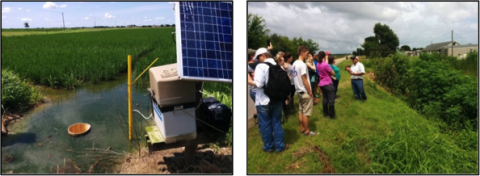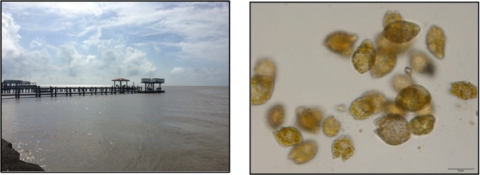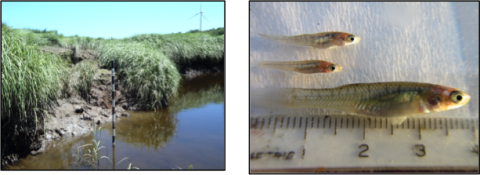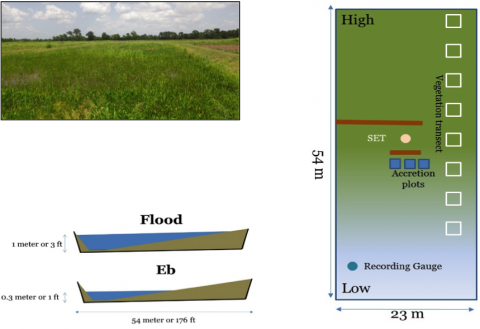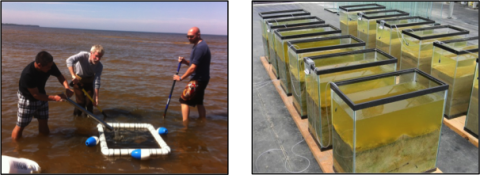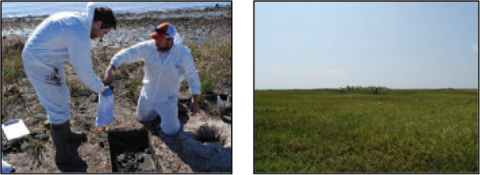Highlighted Research Projects
- Development of barrier island habitat monitoring protocols
- Importance of coastal islands for avifauna support
- Louisiana coastal bays phytoplankton ecology
- Saltmarsh loss disconnects habitats and reduces fish production
- Wetland plant community dynamics modeling
- Coastal wetlands experimental research facility
- Accelerated degradation of petroleum hydrocarbons through bioturbation
- Development of a surface water management framework
- Assessment of oil spill effects on coastal archaeological sites
Development of barrier island habitat monitoring protocols
Currently, researchers at ICaWR are developing monitoring protocols to characterize plant communities and soil properties at barrier islands. These protocols are being tested at Louisiana barrier island restoration sites of different ages to determine methodological efficacy and restoration trajectories, with the ultimate goal of utilizing this monitoring protocol Gulf-wide.
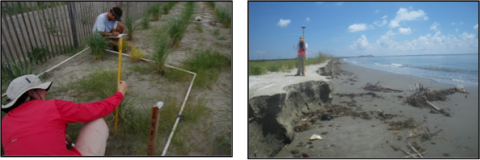
Importance of coastal islands for avifauna support
Since 2007, ICaWR researchers, in collaboration with Tulane University, the US Fish and Wildlife Service and the Louisiana Department of Wildlife and Fisheries, have studied the population ecology of brown pelicans on barrier islands of the Gulf of Mexico. This project is focused on how oil spills, hypoxia, coastal land loss, predators, and restoration approaches affect pelican demographics and population viability.
Louisiana coastal bays phytoplankton ecology
ICaWR researchers are investigating spatial and temporal patterns of phytoplankton biomass and community composition in the Atchafalaya-Vermilion Bay system. Using a combination of field sampling and lab-based experimentation, we are quantifying to what extent physical (e.g., light, salinity), chemical (e.g., nutrients), and biological (e.g., microzooplankton grazing) processes are controlling phytoplankton dynamics in these highly river-influenced estuarine environments.
Saltmarsh loss disconnects habitats and reduces fish production
Using ecosystem scale experiments, ICaWR researchers have demonstrated that degradation of saltmarsh ecosystems decouples food webs that support the growth and production of important forage fishes. Although small and seemingly abundant, decreasing the production of these critical food web linking species can have major consequences for predatory fish that comprise recreational and commercial fisheries.
Wetland plant community dynamics modeling
ICaWR researchers are currently developing models of wetland plant communities that incorporate detailed representation of the ecology of over 30 plant species that characterize important habitat zones including fresh and salt water marshes, forest communities and barrier islands. These models are being used to explore how these communities may respond to anthropogenic and natural changes in the environment.
Coastal wetlands experimental research facility
ICaWR faculty and staff are developing a wetland research facility at the University’s Experimental Farm in Cade, Louisiana. The facility consist of eight experimental coastal wetlands (4 fresh and 4 brackish) that can be programmed with different tidal signals and are outfitted with wetland monitoring instrumentation maintained by ICaWR. This facility allows for student research projects on coastal wetland ecology a half hour from campus.
Accelerated degradation of petroleum hydrocarbons through bioturbation
This GoMRI funded project is a multidisciplinary collaboration (microbial ecology, invertebrate biology, analytical chemistry, environmental toxicology) looking at the interaction between sediment bioturbators, the microbial community, and oiled coastal sediment. It is assessing whether the presence of bioturbators results in an enhanced rate of petroleum hydrocarbon degradation.
Assessment of oil spill effects on coastal archaeological sites
ICaWR researchers are assessing the effects of the 2010 Mississippi Canyon 252 Deepwater Horizon oil spill on prehistoric archaeological sites on the Louisiana Gulf Coast through a cooperative agreement with the Bureau of Ocean Energy Management. Samples have been collected from eight sites to examine the potential effects of hydrocarbons on artifacts, analytical techniques, and site formation processes, as well as long-term site preservation and future research costs for cultural resource management planning.
Development of surface water management framework
ICaWR researchers are working to understand both the human and natural science components that drive the availability, quality, and demand for freshwater resources in the Gulf Coast region. The goal of this project is to find creative and sustainable solutions for meeting our future water needs.
